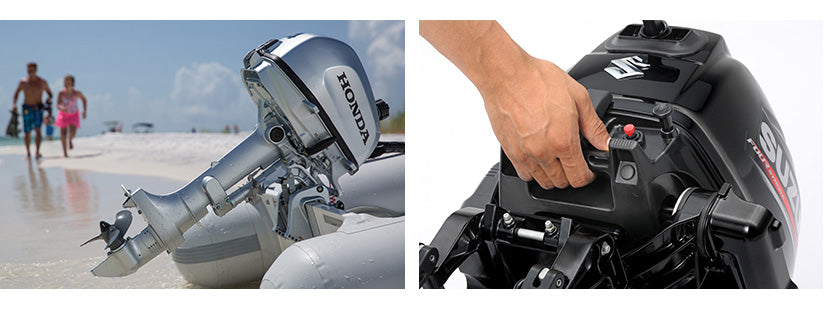Selecting the Right Outboard for Your Boat
Boaters – and prospective boaters – invest considerable time in evaluating different types, makes and models of watercraft before purchasing a boat. But, when buying an outboard motor, do they take enough time to ensure they’re getting the outboard that’s best for their boat and leisure activities? Not always.
That’s why we’re here to help you choose an outboard that’s right for you.
First, how much power do you want?
A good rule of thumb is that you’ll need 5 horsepower per ton of boat. However, when considering factors such as head wind and rough waters – as well as how you plan to use your boat – you may need more. For smaller boats, another good rule of thumb is to have no less than 75-80% of the maximum hp rating for the boat. This insures you’ll have enough thrust to get the boat up on plane and it will drive the way it was intended.
Next, how much speed do you need?
If you want high-speed, you’ll need plenty of power. Depending on the size and weight of your boat, your hull design, and how much cargo you are carrying, you can figure you’ll need to hit 8-12 mph just to get your craft on the plane.
What type of engine do you want?
If there’s one point of discussion in the world of outboard motors, it’s the debate between 2-stroke and 4-stroke motors. In reality, both are good choices. Which is best for you depends on what features are most important to you.
Do you want 2-stroke electronic fuel injection (EFI)? 4-stroke EFI? 2-Stroke direct fuel injection (DFI)? Or an old-school 2-stroke carbureted model (Effective July 1, 2019, U.S. retailers can no longer sell these due to environmental laws and regulations limiting carbon emissions)?
Each motor type has its advantages and disadvantages depending on the type of boat you have and how you want to use it. Take time to learn about them and decide which type is right for you. For example, 2-strokes are generally lighter for the same power and offer a better, faster throttle response, but they also tend to throw more vibration and noise. 2 strokes also are not favorable for low speed use and idling/trolling. And, while 4-strokes may be larger and heavier, they’re also quieter, often have better fuel efficiency and generally offer better speed control.
What type of shaft should you get?
Most inflatables will require a 15” (short) shaft, while fishing boats and yacht auxiliary motors require a long shaft. If you’re not sure what length shaft you’ll need, here’s how to find out.
Measure from the top of the transom to the bottom of the hull – this measurement should be taken in the center of the transom for a single engine application. For a short shaft, your transom height should measure 15 to 17.5 inches. If your transom measures 19 to 22.5 inches, you’ll need a long shaft. And there are extra/ultra-long shafts for transoms measuring taller than 22.5 inches. The ultra/extra long shaft models are commonly used in kicker and auxiliary applications where the outboard is mounted to the port side of a main motor, or on a bracket (as is the case with sailboats).
It’s absolutely vital that you get this right. A short shaft on a long transom may not even reach the water. This will not only affect the flow of water but also the cooling and performance of your motor. An even bigger mistake would be to put a long shaft on a short transom. This scenario is more dangerous, because if the thrust point is too low in the water, the boat could capsize.

Motor Weight
As we mentioned earlier, you need to match the size of your outboard to the size of your boat to ensure that you have sufficient power for speed, maneuverability and safety. However, the advantage of going with a smaller outboard is that it's easier to lift and carry. Most 2HP-10HP outboard motors weigh in the neighborhood of 35 to 90 pounds. When you move up to 20HP-30 HP, you can expect you motor to weigh roughly 100 to 160 pounds.
Manual or Electric Start
Depending on your desire for convenience as well as your budget, you can choose an electric-start option to make starting your outboard easier. However, you will pay extra for the privilege, and you'll also need a 12 V marine cranking battery.
Already have an outboard but want to retrofit it with an electric start? Beware. It may be more cost efficient to buy a new motor with electric start.
Maintenance
Also keep in mind maintenance costs and downtime associated with the type of motor you choose. For example, DFI 2-strokes require a constant supply of oil, while 4-strokes have more moving parts that require more frequent service.
OnlineOutboards.com is your one-stop source for new 4-stroke outboard motors in a variety of fuel delivery and starting options, as well as parts and accessories for 2- and 4-stroke motors, and maintenance kits.
Largest U.S. Outboard Dealer
We stock the most popular models to ensure the best solution anywhere.
About Us
 Monthly Payments
Monthly Payments






